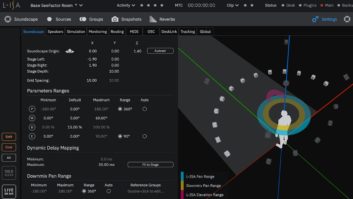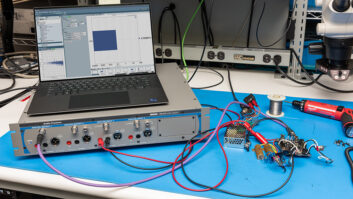True monitors are necessary tools in any studio. Yet, as with any component in the signal chain, monitors need attention, and occasionally a tweak or two to optimize the signal chain. Taking your diagnostics to the next step, your goal is to confirm basic monitor performance, through a process that starts at the console to confirm channel balance across the audio spectrum. The path must be followed all the way to the monitor components to confirm that signals are equally distributed, cleanly and evenly.
Evaluating a monitoring system is not easy. Comparative analysis will only reveal a difference if one monitor is damaged and a spare set of “mains” is unavailable. Otherwise, comparing an equally new or tired pair of monitors won’t be much help. Do consider buying spare components, especially if the manufacturer can provide drivers in matched pairs. Drivers are subject to fatigue, overexcursion or voice coil damage (usually through overloading) as well as aging, where cones, diaphragms and rubber (or foam) surrounds break down or become brittle with time or extended exposure to heat/light/ smoke conditions.
BEFORE YOU BEGIN: REVIEWING THE BASICS
We know that audio and power outlet juices are measured in AC volts and that batteries produce DC volts. Wire “continuity” is measured in ohms. Cables and connectors that are doing their job will measure 0 ohms, although most meters do not have the resolution to say exactly how close to 0. It is easier, although more expensive, to measure level differences in dB rather than in volts. Keep in mind that the decibel is not a voltage but the logarithmic ratio of two voltages. All gear operates at a “nominal” level: professional (+4 dBu) and consumer
(-10 dBV) equipment are referenced to 0 dBu (.775 VRMS) and 0 dBm (1 VRMS), respectively.
Most oscillators do not continuously sweep from 20 to 20k Hz. Since a Range switch typically selects a band of frequencies, be sure to confirm with your ear that the switch is at the correct position. If you see level on the console meters but do not hear it, you may have selected a frequency outside the range of human hearing (above 20 kHz), one that is potentially dangerous to tweeters. (See last month’s “The Tech’s Files” for a suggested list of audio tools. You can also view the complete article online, at www.tangible-technology.com.)
Chasing down intermittent switches, faders or connections (such as the master fader, monitor source switches, Dim attenuator buttons, or mono playback switch) is easier when using a 40Hz sine wave, exercising each of these components to identify the problem component. Sometimes pulling the board’s master module, combined with a couple of well-placed spurts of contact cleaner can work wonders toward improving the signal pathway. A pure bass tone makes it easy to spot intermittent fuzz, but be aware that not all oscillators produce pure sine waves at low frequencies. (The Tenma 72-505 does a decent job for $59.) Note: At any step in the procedure, it is okay to adjust the signal level to produce a voltage or dB reading that is easy to read and compare. Having an assistant to confirm the readings (and write them down) will make your job easier. Provide ear protection for anyone invited to the “audio tone party.”
CHECKING CHANNEL BALANCE
To confirm left and right channel balance, begin at the console. Set the oscillator to 500 Hz (sine), and connect to a single channel of the mixer, panned to the center. Place both the channel fader and the stereo master fader at the nominal position and adjust the oscillator output until the console’s stereo bus meters are at nominal, which could be labeled 0 V, or somewhere between -12 and -20 dB.
Measure the console’s left stereo output, then the right stereo output. (It might be helpful to make a few adapter cables to facilitate the connection to the voltmeter.) The monitors need only be loud enough to confirm that the oscillator is generating the correct frequency range.
If the two channels are not within 0.5 dB, pan hard left and then hard right, measuring each time. (See the table above for voltage and dB relationships.) If the hard-panned difference is within 0.5 dB, the stereo fader is probably okay. (If the stereo fader is actually two mono faders, make the channels agree.) Center the panpot and try again. A difference greater than 0.5 dB but less than 3 dB may indicate a defective panpot. Compare this result with a number of other console channels. If the balance improves, you can thank comparative analysis.
FREQUENCY TEST
Check left and right balance at 20 Hz and 10 kHz. Remember, the monitors are low or off. (Headphones can also be used to confirm oscillator settings, but do not force-feed these tones to your ears.) If channel balance at extreme frequencies is worse, capacitors are suspect. If not, return the oscillator to 500 Hz.
ACTIVE LINE AMPS
In all tests, a channel mismatch of 6 dB is a sign of a wiring error or a failed (active balanced) output amplifier. If the channel balance is within 0.5 dB, leave the faders and panpots where they are and proceed to the Control Room Monitor output. Raise the control-room level to the 9-o’clock position. If this is hair-raising, there is a gain structure error that is most likely to do with the console being referenced to +4 dBu while the power amp (or powered monitors) are referenced to -10 dBV. See both the console and the power amp (powered monitor) literature to determine the output level and input sensitivity options. Once that’s solved, kill the power to the monitors.
Measure both control-room outputs, with the control at 9 o’clock, writing down each value. Now raise the control-room monitor pot straight up, measure and note each channel. Repeat with the control-room pot at the 3-o’clock position. The balance should ideally match at all levels, but it is likely to be better at higher settings and worse at lower settings. If errors are greater than 1 dB, repeat the frequency test.
POWER AMP/DRIVER TEST
By now it should seem obvious that each component in the signal path will be tested. Assuming the control-room pot passed the low-level test, set it to minimum, fire up the power amps, then raise the control-room level until the tone is audible but not life-threatening. (Resume use of earplugs.)
Measure the control-room output again to confirm balance, then measure the output of each power amp using a 500Hz sine wave. For powered monitors, remove the woofer from the cabinet, leaving it connected, and measure at its terminals.
Adjusting the gain pots on the power amps should solve level discrepancies. If these controls do not seem in the same ballpark, repeat the frequency test to rule out the power amp. Signal to the tweeters can be confirmed using a 5kHz sine wave-using ear protection, of course. (When measuring within a monitor, it’s okay to sweep the crossover region to confirm its existence, but when measuring left/right balance, use a frequency that’s centered within the usable range of each driver.)
Drivers can be removed from the cabinet and measured with the voltmeter set to ohms. This is a static DC resistance test, so don’t expect to be closer than within 2 ohms of the stated impedance, which is the speaker’s dynamic resistance averaged over the audio frequency range. A dead driver will either be open (infinite ohms) or shorted (0 ohms). Note the values and return the color-coded wires to their respective
positions.
BRING THE NOISE
To balance a multiple monitor system, route pink noise (from a generator, test CD or another source) to your console’s bus at 20 dB below maximum. Place an SPL meter equidistant from each monitor, feeding one channel at a time. Raise the control-room level until the meter reads 85 dB SPL using the slow, C-weighted curve. Mark the position of the monitor knob. Check the next monitor, adjusting the power amp level (if necessary) to match the first until all channels have been tested.
In the studio, the importance of hearing a faithful representation of the source or tape is essential, and hopefully these suggestions will help keep your system at optimal performance. Additionally, simple maintenance, basic routines-such as cleaning and tightening connections, checking your amp-to-speaker (or mixer-to-powered-monitor) cabling for kinks, damage and proper hookup polarity-should be a regular part of any studio checkup.







